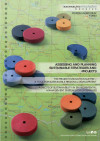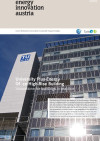Suchergebnisse
aspern Vienna´s Urban Lakeside - subproject 3a: Technology Centre aspern IQ
The demonstration project "Technology centre aspern IQ" showed that the energy required for space conditioning (heating, cooling, ventilation, lighting, hot water) can be covered from domestic energy production.
Product-related Environmental Information Systems in Austrian Companies
Inventory of product-related environmental information systems, survey of implementations within Austrian companies, and analysis with respect to principle applications
Smart ABC Smart Energy Efficient Active Buildings and Building Clusters
The EPBD recast 2010 targeted "nearly zero energy buildings". This low amount of energy is to be covered by energy from renewable energy sources. The project "Smart ABC" analysed a variety of relevant solution sets regarding the building performance and the renewable based energy supply options. Energetic and ecological impacts were analyzed in order to optimize the integration of renewable energy technologies in building standards and to find answers how to depict a building cluster regarding standards and tools.
Maize Cob Board (MCB) - Light weight material from agricultural by-products
Maize cobs accrue as an agricultural by-product can be used for a core material of light weight panels with good material properties and insulation characteristics. The aim was to work out a concept for the production and optimisation of material properties.
"gugler! build & print triple zero" - Subproject 7: Integrated General Planning
The aim of the subproject 7 is to aggregate a "normal" general planning process with innovative additional services. In the spirit of integrated planning in the design a higher number of design parameters must be resolved. This is different to a classic planning process with linear and chronological lined up add ons.
Einfach:wohnen, integrated concept for multi-storey residential buildings
The aim of the project is to create a base for future social residential housing projects, for further projects and the development of standards in the field of passive and low energy houses.
Sustainable energy supply: Production and import of biomass and bio fuels
The project gives an overview of the supply and demand for biofuels specifically dealing with the situation in Europe and that in threshold and developing countries using case studies as examples. Cases: Sweden and France as importing countries in the EU, and Senegal as a (potential) exporting nation.
PHplusCAD, IT-based efficient Passive house- and Plusenergy house-Planning
Elaboration and programming of a software that reduces effort and time consumption of Passive house and Plusenergy house planning. By developing direct interfaces between CAD-applications and PHplusCAD and interfaces between PHplusCAD and Passivhouse planning tools based on MS Excel the system could be improved and the related working processes alleviated.
BIGMODERN - Subproject 8: Demonstration building Amtshaus Bruck - Realisation
In the frame of the flagship project BIGMODERN the "Amtshaus Bruck an der Mur" had been renovated according to above-average quality standards concerning energy efficiency and sustainability while complying with an industrial management point of view.
First rehabilitation project of a public building to reach passive-house standard

General rehabilitation of the General Secondary School II and the Poytechnic School at Schwanenstadt (Upper Austria) using prefabricated timber wall elements and a newly developed ventilation system optimised for schools
Local Biomass Heating Systems And Solar Energy In Austria

Models for the successful diffusion of new technologies
Forschungsforum
2/1996
Herausgeber: BMVIT
Englisch, 6 Seiten
green LIGHT: light, fresh air, exterior space, greening in the large volume PassivHaus

theoretical topics: Optimization of natural light, ambient humidity and of private exterior space, planted over buildings, evaluation of the energetic performance and special challenges of large volume "Passivhaus" residential buildings. applied research: concept for the renovation of a 13 storey residential building for senior citizens built in 1974 to PassivHaus standards, applying the results attained in the theoretical part.
Assessing And Planning Sustainable Strategies And Projects

The Project Innovation Matrix - A Tool For Sustainable Regional Development Aspects Of Sustainability In Environmental Management Systems For Enterprises
Forschungsforum
1/2003
Herausgeber: BMVIT
Englisch, 6 Seiten
Downloads zur Publikation
Competence- and knowledge centre of renewable energies and passive house technology

Arrangement of a passive house village for test living in the context of an innovative settlement expansion. Building up a large dimensioned passive house for consulting, training, exhibitions, research and distribution of passive house technology and know-how in the field of energy efficient and sustainable building.
University Plus-Energy Office High-Rise Building

Innovations for buildings in practice
Herausgeber: BMVIT und Klima- und Energiefonds
Englisch, 8 Seiten
Downloads zur Publikation
NIM Industry Insights Series - Carbon Shift: Redefining Industry Through CCUS
21. May 2025, 11:00 – 13:15 CEST
Online, AT
The event will spotlight the transformative role of Carbon Capture, Utilization and Storage (CCUS) in industrial decarbonisation and explore current progress, strategic funding opportunities, and collaborative projects from across Europe.
IEA HPP Annex 33: Compact heat exchangers for heat pumping equipment
International cooperation aiming at widening the use of compact heat exchangers in heat pumping equipment. The goal of this project is to identify compact heat exchangers, either existing or under development, that may be applied in heat pumping equipment such as compression or absorption heat pumps.
Bio-R: Applications for treating Cellulosic bodies with supercritical carbon dioxide
The target of this project is the screening of the opportunities, resulting of the combination of treating Cellulosic bodies with supercritical carbon dioxide. In general, the change of the porous structure depending on the way of fiber drying and the opportunity to incorporate active compounds and the development of analytical methods to track them within Cellulosic bodies.
New potentials using hardwood with small diameters in forestry and timber industry
Identification of potentials to use hardwood with small diameters (SDH) in Austria with the help of the value added chain from the forest's location to the processor. Analysis and evaluation of availability, quality and market potential.
IEA SHC Task 37: Advanced Housing Renovation with Solar & Conservation
Development of advanced renovation concepts for residential buildings. For the housing segments with the greatest energy saving potentials strategies for increased market penetration of advanced housing renovation are investigated. Analysing outstanding renovation projects shall lead to technically and economically robust and sustainable concepts for housing renovation.
